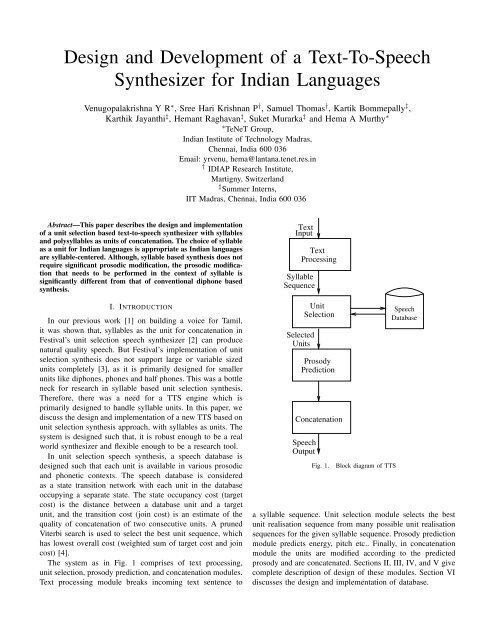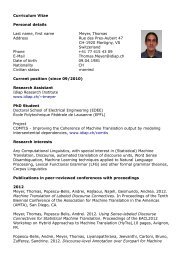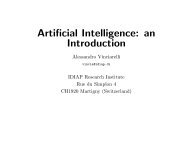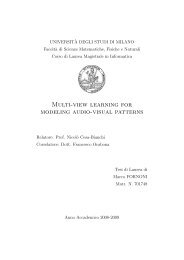Design and Development of a Text-To-Speech - Idiap Research ...
Design and Development of a Text-To-Speech - Idiap Research ...
Design and Development of a Text-To-Speech - Idiap Research ...
You also want an ePaper? Increase the reach of your titles
YUMPU automatically turns print PDFs into web optimized ePapers that Google loves.
<strong>Design</strong> <strong>and</strong> <strong>Development</strong> <strong>of</strong> a <strong>Text</strong>-<strong>To</strong>-<strong>Speech</strong><br />
Synthesizer for Indian Languages<br />
Venugopalakrishna Y R ∗ , Sree Hari Krishnan P † , Samuel Thomas † , Kartik Bommepally ‡ ,<br />
Karthik Jayanthi ‡ , Hemant Raghavan ‡ , Suket Murarka ‡ <strong>and</strong> Hema A Murthy ∗<br />
∗ TeNeT Group,<br />
Indian Institute <strong>of</strong> Technology Madras,<br />
Chennai, India 600 036<br />
Email: yrvenu, hema@lantana.tenet.res.in<br />
† IDIAP <strong>Research</strong> Institute,<br />
Martigny, Switzerl<strong>and</strong><br />
‡ Summer Interns,<br />
IIT Madras, Chennai, India 600 036<br />
Abstract—This paper describes the design <strong>and</strong> implementation<br />
<strong>of</strong> a unit selection based text-to-speech synthesizer with syllables<br />
<strong>and</strong> polysyllables as units <strong>of</strong> concatenation. The choice <strong>of</strong> syllable<br />
as a unit for Indian languages is appropriate as Indian languages<br />
are syllable-centered. Although, syllable based synthesis does not<br />
require significant prosodic modification, the prosodic modification<br />
that needs to be performed in the context <strong>of</strong> syllable is<br />
significantly different from that <strong>of</strong> conventional diphone based<br />
synthesis.<br />
I. INTRODUCTION<br />
In our previous work [1] on building a voice for Tamil,<br />
it was shown that, syllables as the unit for concatenation in<br />
Festival’s unit selection speech synthesizer [2] can produce<br />
natural quality speech. But Festival’s implementation <strong>of</strong> unit<br />
selection synthesis does not support large or variable sized<br />
units completely [3], as it is primarily designed for smaller<br />
units like diphones, phones <strong>and</strong> half phones. This was a bottle<br />
neck for research in syllable based unit selection synthesis.<br />
Therefore, there was a need for a TTS engine which is<br />
primarily designed to h<strong>and</strong>le syllable units. In this paper, we<br />
discuss the design <strong>and</strong> implementation <strong>of</strong> a new TTS based on<br />
unit selection synthesis approach, with syllables as units. The<br />
system is designed such that, it is robust enough to be a real<br />
world synthesizer <strong>and</strong> flexible enough to be a research tool.<br />
In unit selection speech synthesis, a speech database is<br />
designed such that each unit is available in various prosodic<br />
<strong>and</strong> phonetic contexts. The speech database is considered<br />
as a state transition network with each unit in the database<br />
occupying a separate state. The state occupancy cost (target<br />
cost) is the distance between a database unit <strong>and</strong> a target<br />
unit, <strong>and</strong> the transition cost (join cost) is an estimate <strong>of</strong> the<br />
quality <strong>of</strong> concatenation <strong>of</strong> two consecutive units. A pruned<br />
Viterbi search is used to select the best unit sequence, which<br />
has lowest overall cost (weighted sum <strong>of</strong> target cost <strong>and</strong> join<br />
cost) [4].<br />
The system as in Fig. 1 comprises <strong>of</strong> text processing,<br />
unit selection, prosody prediction, <strong>and</strong> concatenation modules.<br />
<strong>Text</strong> processing module breaks incoming text sentence to<br />
<strong>Text</strong><br />
Input<br />
Syllable<br />
Sequence<br />
<strong>Text</strong><br />
Processing<br />
Selected<br />
Units<br />
Unit<br />
Selection<br />
Prosody<br />
Prediction<br />
Concatenation<br />
<strong>Speech</strong><br />
Output<br />
Fig. 1. Block diagram <strong>of</strong> TTS<br />
<strong>Speech</strong><br />
Database<br />
a syllable sequence. Unit selection module selects the best<br />
unit realisation sequence from many possible unit realisation<br />
sequences for the given syllable sequence. Prosody prediction<br />
module predicts energy, pitch etc.. Finally, in concatenation<br />
module the units are modified according to the predicted<br />
prosody <strong>and</strong> are concatenated. Sections II, III, IV, <strong>and</strong> V give<br />
complete description <strong>of</strong> design <strong>of</strong> these modules. Section VI<br />
discusses the design <strong>and</strong> implementation <strong>of</strong> database.
ajaji/<br />
/ rajaji/<br />
/ raja/, /ji/<br />
/ra/, /jaji/<br />
/ra/, /ja/, /ji/<br />
/r/, /a/, /j/, /a/, /j/, /i/<br />
Fig. 2. Syllabification Procedure<br />
II. TEXT PROCESSING<br />
<strong>Text</strong> input to the synthesizer can be in transliterated form or<br />
in UTF-8 [5] form. If incoming text is in UTF-8 form it will be<br />
converted to the transliterated form before further processing.<br />
The <strong>Text</strong> processing module consists <strong>of</strong> preprocessing <strong>and</strong><br />
syllabification modules. The text in transliterated form is<br />
preprocessed to remove invalid characters in the text. And also,<br />
preprocessing module adds phrase break indicators to the text<br />
based on full stops <strong>and</strong> case markers. The preprocessed text<br />
is further passed on to the syllabification module.<br />
A. Syllabification<br />
It is hard to cover all the syllable units <strong>of</strong> a language in<br />
the database. And also it is not possible to cover all <strong>of</strong> them<br />
in various contexts. So, there will be a need to h<strong>and</strong>le the<br />
case <strong>of</strong> missing units. Considering this, two approaches <strong>of</strong><br />
syllabification are used.<br />
In the first approach, the syllabification algorithm breaks a<br />
word such that there are minimum number <strong>of</strong> breaks in the<br />
word, as minimum number <strong>of</strong> joins will have less artefacts.<br />
The algorithm dynamically looks for polysyllable units making<br />
up the word, cross checks the database for availability <strong>of</strong> units,<br />
<strong>and</strong> then breaks the word accordingly. If polysyllable units<br />
are not available, then algorithm naturally picks up smaller<br />
units. This mean, if database is populated with all available<br />
phones <strong>of</strong> language alongwith syllable units, algorithm falls<br />
back on phones if bigger units are not available. For example,<br />
as in Fig. 2, for breaking a word “rajaji” algorithm looks<br />
for unit “/rajaji/” in database, if not found it looks for unit<br />
combinations such as “/raja/, /ji/”, “/ra/, /jaji/” etc.. This way,<br />
it finally falls back on phone sequence “/r/, /a/, /j/, /a/, /j/, /i/”.<br />
In the second approach, the syllabification algorithm [6]<br />
breaks a word into monosyllables without checking for its<br />
availability in the database. Here syllabification is done based<br />
on st<strong>and</strong>ard linguistic rules. By this method “rajaji” is broken<br />
as “/ra/, /ja/, /ji/”. If a unit is not found it can be substituted<br />
by a nearest unit or by silence.<br />
III. UNIT SELECTION<br />
Unit selection module is responsible for selecting the best<br />
unit realisation sequence from many possible unit realisation<br />
sequences from the database. Basic cost measures, target cost<br />
<strong>and</strong> join cost [7] were used in searching for the best unit<br />
sequence. On using syllables as units, phoneme centric target<br />
features like phoneme type, place <strong>of</strong> articulation etc. used<br />
in Festival loose their meaning. Features such as position <strong>of</strong><br />
the syllable in the word (begin, middle <strong>and</strong> end), position <strong>of</strong><br />
the syllable in the sentence are important <strong>and</strong> can be used<br />
in target cost evaluation. As syllables are prosodically rich<br />
units, using them in appropriate position <strong>of</strong> the word is very<br />
important. In this implementation, instead <strong>of</strong> using position <strong>of</strong><br />
the syllable in the word in target cost, we have pre-classified<br />
units according to position <strong>of</strong> the syllable in the word as<br />
begin, mid <strong>and</strong> end. During unit selection,<br />
the units are picked based on this classification. Begin<br />
correspond to unit obtained from the beginning <strong>of</strong> a<br />
word, mid correspond to unit obtained from the<br />
middle <strong>of</strong> a word <strong>and</strong> end correspond to unit <br />
obtained from the end <strong>of</strong> a word.<br />
Join cost is the measure <strong>of</strong> how good is the joining between<br />
two consecutive units. MFCC based spectral distance<br />
(euclidean) (1) measure between last frame <strong>of</strong> one unit <strong>and</strong><br />
first frame <strong>of</strong> the next unit is used in evaluating the join cost.<br />
C c s (ui−1, ui) =<br />
N�<br />
(X(j) − Y (j)) 2<br />
j=1<br />
where N is dimension <strong>of</strong> MFCC vector, ¯ X is MFCC vector <strong>of</strong><br />
the last frame <strong>of</strong> (i − 1) th unit ui−1 <strong>and</strong> ¯ Y is MFCC vector<br />
<strong>of</strong> the first frame <strong>of</strong> i th unit ui.<br />
Other prosodic features like pitch <strong>and</strong> energy can also be<br />
used in evaluating join cost. In such cases, the join cost,<br />
given weights wc j , is calculated as follows:<br />
C c (ui−1, ui) =<br />
q�<br />
j=1<br />
(1)<br />
w c j Cc j (ui−1, ui) (2)<br />
where q is number <strong>of</strong> prosodic features <strong>and</strong> C c j is join cost <strong>of</strong><br />
jth prosodic feature.<br />
Viterbi search algorithm is used to find the unit sequence<br />
with minimum overall cost. Unit selection procedure for<br />
synthesizing a word “rajaji” from various realizations <strong>of</strong> units<br />
/ra/, /ja/ <strong>and</strong> /ji/ is shown in Fig. 3.<br />
IV. PROSODY PREDICTION AND MODIFICATION<br />
In prosody prediction module prosodic features like energy,<br />
pitch etc. are predicted for the selected syllables. During<br />
recording <strong>of</strong> prompts, the prosody with which voice talent<br />
reads the prompt varies over the length <strong>of</strong> the recording.<br />
In addition, syllables used in concatenation are picked from<br />
different contexts. Because <strong>of</strong> these reasons, audible discontinuity<br />
due to discontinuous prosodic contours is perceived in<br />
the synthesized speech. <strong>To</strong> correct these prosodic contours,<br />
Classification <strong>and</strong> Regression Tree (CART) [8] is used in<br />
predicting prosody for the selected units.<br />
The construction <strong>of</strong> CARTs has become a common basic<br />
method for building statistical models from simple feature
Target Target Target<br />
/ra/ /ja/ /ji/<br />
ra1<br />
ra2<br />
ra10<br />
ja1<br />
ja2<br />
ja21<br />
ji1<br />
ji2<br />
ji32<br />
Fig. 3. Unit Selection Procedure showing selection <strong>of</strong> units /ra/, /ja/,<br />
/ji/<br />
data. CART is powerful because it can deal with incomplete<br />
data, multiple types <strong>of</strong> features (floats, unumerated sets) both<br />
in input features <strong>and</strong> predicted features, <strong>and</strong> the trees it<br />
produces <strong>of</strong>ten contain rules which are humanly readable.<br />
Wagon [9], a tool part <strong>of</strong> EST (Edinburgh <strong>Speech</strong> <strong>To</strong>ols)<br />
library is used to build CART.<br />
For example, CART was built for predicting energy for<br />
the units. We used syllable name, previous syllable name,<br />
next syllable name, position <strong>of</strong> the syllable in the word<br />
(begin, end, middle, single) <strong>and</strong> normalized position <strong>of</strong> the<br />
word containing syllable in the sentence (float value from<br />
0 to 1) as the input features for predicting peak amplitude<br />
level <strong>of</strong> the syllable unit. CART was built from a data set<br />
made up <strong>of</strong> 450 sentences corresponding to 45 minutes <strong>of</strong><br />
speech. The correlation coefficient which is indicative <strong>of</strong> how<br />
well CART predicts the expected energy was 0.91. CART is<br />
used to predict the peak amplitude <strong>of</strong> each <strong>of</strong> the syllables<br />
in the sentences. The syllable waveforms are then scaled<br />
appropriately in concatenation module.<br />
V. WAVEFORM CONCATENATION<br />
Selected speech units are modified according to the predicted<br />
prosody <strong>and</strong> concatenated to form a single speech<br />
file. TD-PSOLA [10] algorithm is implemented to scale pitch<br />
<strong>and</strong> duration. Energy <strong>of</strong> the syllable is also scaled based on<br />
predicted value <strong>of</strong> peak amplitude.<br />
Apart from waveform concatenation, linear prediction based<br />
speech synthesis module is also provided as an optional module.<br />
LP coefficients <strong>and</strong> residual are precomputed for speech<br />
units in the database <strong>and</strong> later used in producing the synthetic<br />
speech for selected units. When spectra at unit boundaries need<br />
to be modified, LP synthesis can be a useful technique. This<br />
is yet to be implemented in the synthesizer.<br />
0<br />
1<br />
2<br />
3<br />
798<br />
799<br />
||UNIT|| ||UNIT|| ||UNIT||<br />
||UNIT|| ||UNIT|| ||UNIT||<br />
||UNIT|| ||UNIT|| ||UNIT||<br />
||UNIT|| ||UNIT|| ||UNIT||<br />
||FEAT|| ||WAV||<br />
b m e s b m e s<br />
||m1.feat||<br />
||m2.feat||<br />
||mN.feat||<br />
||b1.wav||<br />
||b2.wav||<br />
||bK.wav||<br />
Fig. 4. Pictorial view <strong>of</strong> Database<br />
VI. DATABASE DESIGN<br />
The sentences were designed from DBIL [13] <strong>and</strong> consists<br />
<strong>of</strong> 1180 prompts. Later, prompts were recorded in a near<br />
anechoic chamber by a voice talent. Recorded prompts were<br />
manually labeled at word level <strong>and</strong> then they were segmented<br />
<strong>and</strong> labeled into syllable-like units using Group-Delay based<br />
segmentation algorithm [11], [12]. Syllable segments from<br />
continuous speech database are extracted <strong>and</strong> classified into<br />
begin, mid, end <strong>and</strong> single units based on their position in the<br />
word. Each syllable segment has a corresponding feature file<br />
describing unit’s phonetic <strong>and</strong> prosodic context. Details in this<br />
feature file can be used in target cost evaluation.<br />
In this implementation, TTS on initialisation, loads entire<br />
database containing syllable segments <strong>and</strong> their feature<br />
descriptions into a data structure. The data is stored in a<br />
hash table. Every syllable unit is hashed into one <strong>of</strong> the 800<br />
buckets <strong>of</strong> the hash table. Syllable segments <strong>and</strong> their feature<br />
descriptions are stored using linked lists under hash list. A<br />
pictorial view <strong>of</strong> data structure used is shown in Fig. 4.<br />
VII. CONCLUSION<br />
We have discussed design <strong>and</strong> development <strong>of</strong> a textto-speech<br />
synthesizer for Indian languages. Our design is<br />
centered around using larger or variable sized units (syllables)<br />
in synthesis. We have pre-classified units according to their<br />
position in the word. This improves synthesis quality <strong>and</strong><br />
it reduces search space improving the synthesis timing.<br />
Database design based on hash tables also reduces search<br />
time. We need to use other phonetic features like identity<br />
<strong>and</strong> position <strong>of</strong> previous, next units in target cost evaluation.<br />
Alongwith this, prosodic descriptions such as average pitch,<br />
duration <strong>and</strong> energy must also be used in target cost. Although<br />
LP based synthesis is implemented, it is not clear at the<br />
time <strong>of</strong> writing, how spectral interpolation will be performed<br />
at the boundaries. Web interface for Hindi voice on our<br />
TTS is available at URL http://lantana.tenet.res.in/apache2default/<strong>Research</strong>/<strong>Speech</strong>/TTS/DonlabTTS/Transliteration1.php.
ACKNOWLEDGMENT<br />
The authors would like to thank IBM for funding the summer<br />
interns vide project no: CSE/06-07/087/IBMC/HEMA.<br />
REFERENCES<br />
[1] Samuel Thomas, M. Nageshwara Rao, Hema A. Murthy, C. S. Ramalingam,<br />
“Natural Sounding TTS based on Syllable-like Units”, Proceedings<br />
<strong>of</strong> 14th European Signal Processing Conference, Florence, Italy, Sep<br />
2006.<br />
[2] The Center for <strong>Speech</strong> Technology <strong>Research</strong>, The University <strong>of</strong> Edinburgh,<br />
http://www.cstr.ed.ac.uk/projects/festival/.<br />
[3] Robert A.J. Clark, Korin Richmond, <strong>and</strong> Simon King, “Festival 2 - build<br />
your own general purpose unit selection speech synthesiser”, In Proc. 5th<br />
ISCA workshop on speech synthesis, 2004.<br />
[4] Andrew J. Hunt <strong>and</strong> Alan W. Black, “Unit selection in a concatenative<br />
speech synthesis system using a large speech database”, Proceedings <strong>of</strong><br />
IEEE Int. Conf. Acoust., <strong>Speech</strong>, <strong>and</strong> Signal Processing, 1996, vol. 1, pp.<br />
373–376.<br />
[5] F. Yergeau, “UTF-8, a transformation format <strong>of</strong> ISO 10646”, November<br />
2003.<br />
[6] Lakshmi A. <strong>and</strong> Hema A. Murthy, “A Syllable based continuous speech<br />
recognizer for Tamil”, Interspeech 2006, ICSLP, Pittsburgh, Sep. 2006.<br />
[7] A.W. Black <strong>and</strong> P. Taylor, “Automatically clustering similar units for unit<br />
selection in speech synthesis”, Proceedings <strong>of</strong> EUROSPEECH, 1997, pp.<br />
601–604.<br />
[8] L.J. Breiman, H.Friedman, R.A. Olshen <strong>and</strong> C.J. Stone, “Classification<br />
<strong>and</strong> Regression Trees”.<br />
[9] A.W. Black <strong>and</strong> K.A. Lenzo, “Building synthetic voices”, 2003,<br />
http://festvox.org/bsv/<br />
[10] E. Moulines <strong>and</strong> Charpentier F., “Pitch-synchronous waveform processing<br />
techniques for text-to-speech synthesis using diphones”, specom,<br />
1990, pp. 9(5/6):453-467.<br />
[11] T. Nagarajan, H. A. Murthy <strong>and</strong> R. M. Hegde, “Segmentation <strong>of</strong> speech<br />
in to syllable-like units”, in proceedings <strong>of</strong> EUROSPEECH, 2003, pp.<br />
2893-2896.<br />
[12] T. Nagarajan <strong>and</strong> H. A. Murthy, “Group delay based segmentation<br />
<strong>of</strong> spontaneous speech into syllable-like units”, EURASIP Journal <strong>of</strong><br />
Applied signal processing, vol. 17, pp.2614-2625, 2004.<br />
[13] “Database for Indian Languages”, <strong>Speech</strong> <strong>and</strong> Vision Lab, IIT Madras,<br />
India, 2001.





